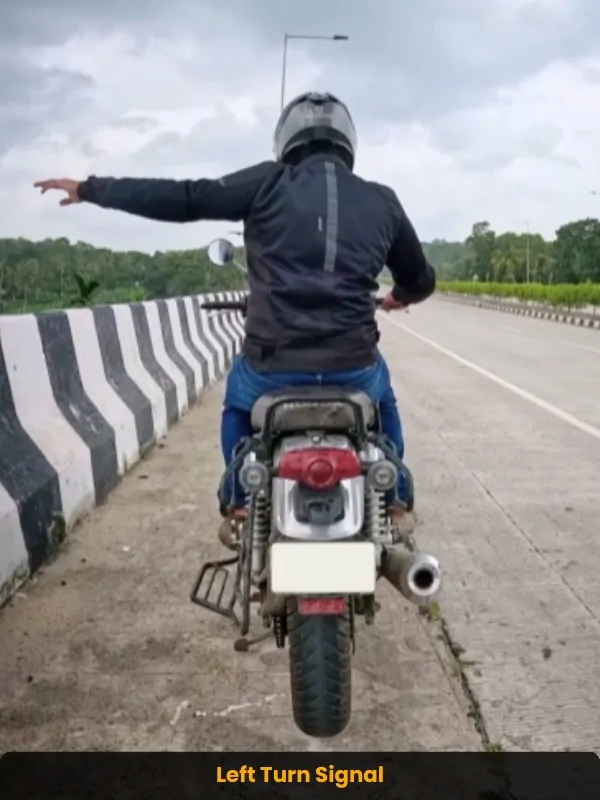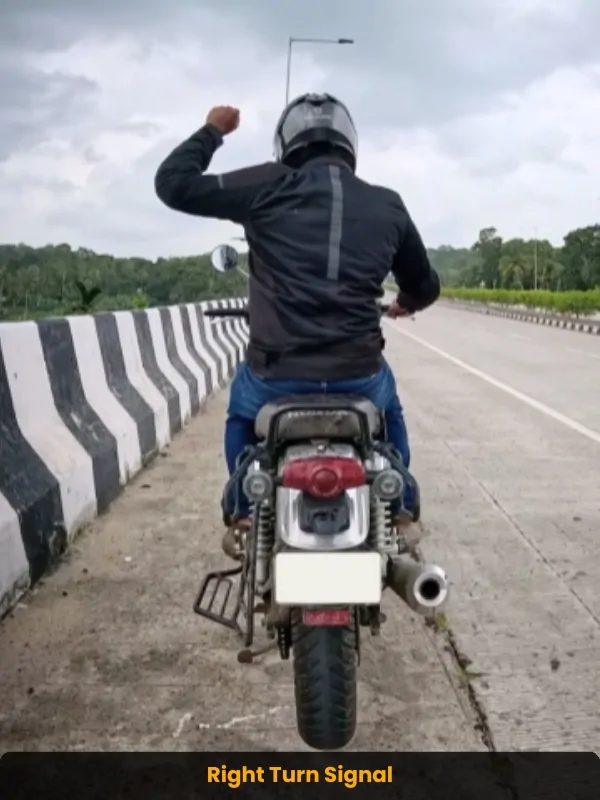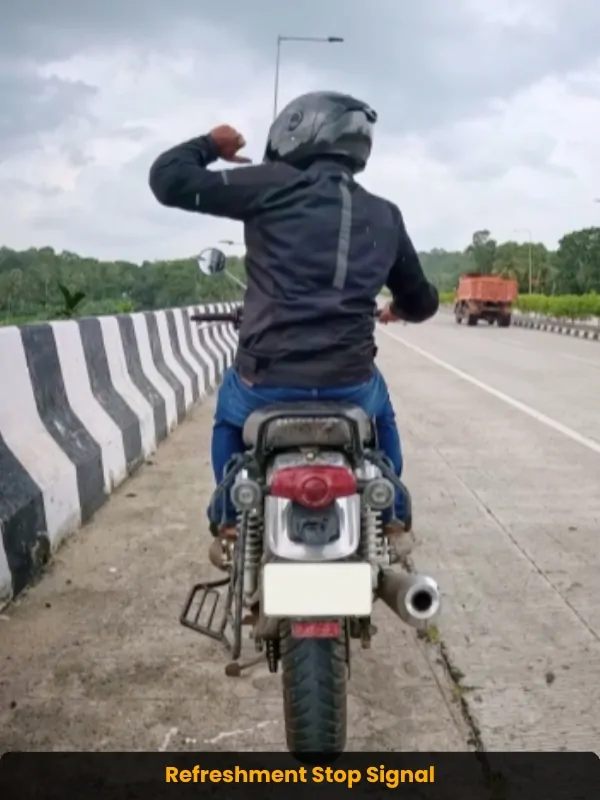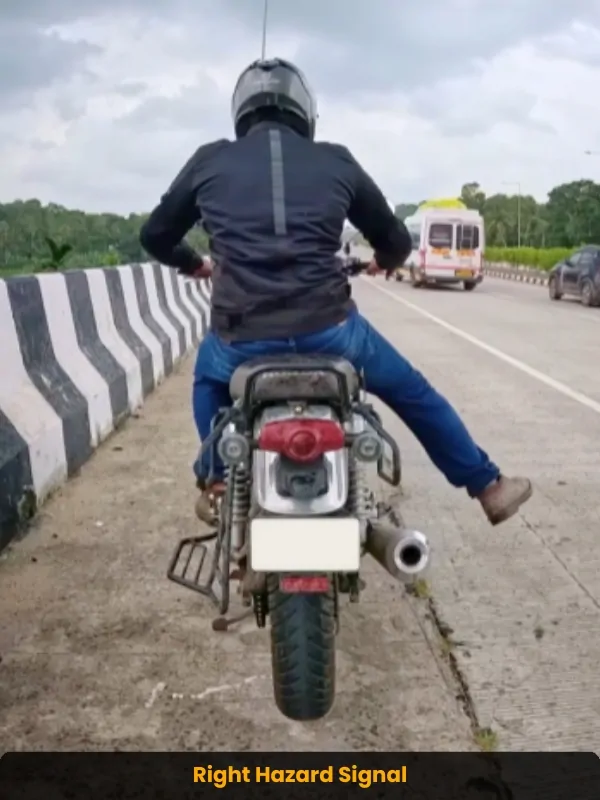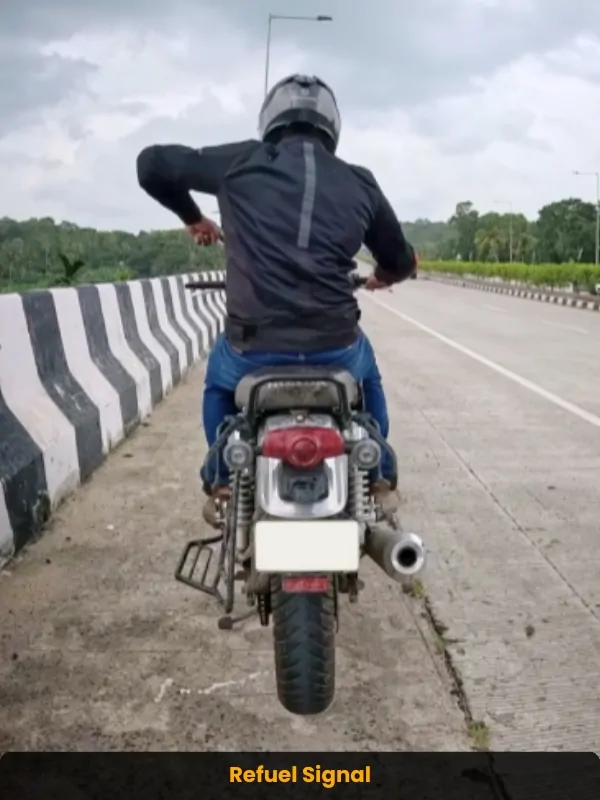
Long story short: Learn essential motorcycle hand signals, their meanings, and safety tips for riders in India to ensure safe and clear communication on the road.
Learn essential motorcycle hand signals to enhance safety and communication during rides in India. This guide covers key signals for turns and stops that every rider should master for smoother group rides. Understand the importance of using these signals, common mistakes to avoid, and how to communicate effectively on the road. Ride safely and confidently with explicit signalling.
Key Takeaways
- Hand signals are vital for motorcyclists, allowing them to communicate clearly about turns, stops, hazards, and group coordination—especially when indicators fail or aren’t visible.
- Riders always use the left hand for signals to maintain throttle and brake control with the right hand, ensuring safety and stability.
- Clear, consistent, and sustained hand signals improve visibility and understanding among group members and nearby drivers, reducing the risk of accidents.
- Practising and standardising universal signals before group rides helps build coordination, making group riding smoother and more disciplined.
- Common mistakes such as unclear gestures, using the wrong hand, or forgetting to signal can lead to miscommunication—so riders must stay attentive, visible, and consistent with their signals.
What is a hand signal on a motorcycle?
A hand signal on a motorcycle is a simple gesture made with the rider’s hand, usually the left, to show intentions or warnings to others nearby. Riders use these signals to indicate turns, stops, slowing down, warn about hazards, or coordinate in groups when talking isn’t possible or safe.
For example:
- Extending the left arm straight out horizontally signals a left turn.
- Bending the left arm upwards at a 90-degree angle with a clenched fist indicates a right turn.
- Pointing the left arm downward at a 90-degree angle with the palm facing backwards means the rider is stopping.
What is the importance of hand signals on a motorcycle?
Hand signals are essential for motorcyclists because they enable riders to communicate their intentions or warn others in a way that everyone can understand. These signals help keep everyone safe and make it easier for riders to work together, especially when signal lights are not visible or not functioning.
The importance of motorcycle hand signals includes:
- Safety: Hand signals help riders communicate their intentions to others, such as turning or stopping, reducing the likelihood of crashes or accidents.
- Visibility: Often, turn signals are challenging to see, especially in bright sunlight or heavy traffic. Hand signals make it easier for others to notice what a rider wants to do.
- Group Coordination: During group rides, hand signals help riders share information about speed changes, formation, road conditions, or stops. This keeps the group organised and prevents confusion.
- Redundancy: Hand signals serve as a backup method of communication when lights are not functioning or are not visible to others.
- Clarity: Hand signals convey a clear message to others nearby, which is especially important in noisy or busy traffic.
- Universal Language: These signals are used universally, making them effective even in areas where people speak different languages or follow different driving customs.
Using hand signals correctly helps you ride safely and develop good habits. This can help you avoid accidents and increase your confidence, whether you ride alone or with a group.
In short, hand signals are a crucial means of communication for motorcyclists, enabling them to stay safe and work together effectively. They help make the road safer for everyone.
Why is the left hand used for motorcycle hand signals?
Motorcyclists use their left hand for signals because the right hand controls the throttle and front brake for safety. Taking your right hand off could cause you to lose speed or accidentally brake, which is risky, especially in traffic or at high speeds.
Using the left hand helps riders keep control of the motorcycle while signalling. This is a common practice everywhere for safer riding.
What are the Universal Hand Signals for Motorcycle Riders?
Universal hand signals are simple ways for motorcycle riders to communicate safely during group rides, wherever they are. These standard signals let riders show actions like turning, stopping, slowing down, or warning about hazards without speaking, which is often not possible while riding.
Here are some common universal hand signals used by motorcycle riders in group rides. These are helpful for everyone, including riders in India:
- Left turn – Arm and hand extending left, palm facing down.
- Right turn – Arm out, bent at a 90° angle, fist clenched.
- Stop – Arm extended straight down, palm facing back.
- Speed Up – Arm extended straight out, palm facing up, swing upward.
- Slow Down – Extend your arm straight out, palm facing down, and swing it down to your side.
- Follow Me – Arm extended straight up from the shoulder, palm forward.
- You Lead/Come – Arm extended upward 45°, palm forward, pointing with index finger, swing in an arc from back to front.
- Hazard in Roadway – On the left, point with left hand; on the right, point with right foot.
- Single File – Arm and index finger extended straight up.
- Double File – Arm with index and middle finger extended straight up.
- Comfort Stop – Forearm extended, fist clenched with a short up and down motion.
- Refreshment Stop – Fingers closed, thumb to mouth.
- Turn signal On – Open and close hand with fingers and thumb extended.
- Pull Off – Arm positioned as for right turn, forearm swung toward the shoulder.
- Cops Ahead – Tap on top of the helmet with an open palm down.
- Fuel – Extend your arm out to the side, pointing to the tank with your finger extended.
Best Practices
- Always use the left hand for signalling to maintain throttle control with the right hand.
- Keep arm signals clear and deliberate.
- Combine signals with head nods or eye contact when safe.
- Practice these signals during rides to build familiarity within the group.
Motorcycle enthusiasts worldwide, including those in India, use these signals. They help keep group rides safe and facilitate easier communication.
Rider groups can create or add signals to meet their own needs if necessary. Still, using the main universal signals helps everyone understand each other, even across different groups.
These universal hand signals form the foundation for safe and professional group riding on motorcycles.
What are the Safety Tips for Hand Signals for Motorcycle Riders in India?
In India, using universal motorcycle hand signals should be accompanied by essential safety practices, both during group and solo rides.
1. Use the Left Hand for Signalling
Always use your left hand for signals. The right hand controls the throttle and brake, so using it can cause sudden speed changes that might affect riders behind you. In India, the left side of your body is also easier for others to see because vehicles drive on the left side of the road.
2. Make Signals Clear and Sustained
Hold each hand signal clearly for a few seconds so riders behind you can see and understand it. Avoid quick or jerky movements that could confuse others.
3. Signal Well in Advance
Start signalling well before you make a move, ideally at least 100 feet ahead, depending on your speed and traffic. This gives other riders and drivers time to react safely to what you plan to do.
4. Practice Group Communication Etiquette
Make sure everyone in your riding group understands the same hand signals for turns, stops, hazards, and formations. Practice these signals together in safe places before group rides.
5. Enhance Visibility
Wear bright or reflective gloves and gear to make your hand signals more visible, especially at night or in low light. Ensure your signals are clear and avoid awkward positions that could compromise your control of the bike.
6. Combine Signals with Other Safety Measures
Use hand signals in conjunction with your bike’s indicators and brake lights to communicate more effectively with everyone on the road. When possible, confirm your signals with eye contact or a nod of the head to other group riders for added clarity.
7. Avoid Signalling in Dangerous Conditions
Don’t use hand signals when you need both hands on the controls, such as in tight corners, on slippery roads, or when merging into heavy traffic. Always keep complete control of your motorcycle by using your lights and adjusting your position as needed.
8. Be Cautious of Traffic Around You
Stay aware of the traffic around you. Your signals shouldn’t distract or confuse other drivers. When warning about hazards or police ahead, make sure your hand signals don’t cause panic or sudden braking in the group.
9. Emergency Signals
For emergencies, wave your arm to stop or point out obstacles clearly and promptly. These signals help prevent accidents in unexpected situations during group rides.
By following these safety tips and using hand signals, motorcycle riders in India can ride more safely together, reduce the risk of accidents, and enjoy their rides in various conditions.
What should a rider do if another rider does not understand or respond to a hand signal?
If a rider sees that another rider does not understand or respond to a hand signal during a group ride, here are some critical steps to take:
- Re-Signal Clearly: Repeat the signal in a more obvious way and hold it a bit longer so the other rider can see and understand it. Use precise, bigger movements to avoid confusion.
- Use Additional Communication: Add head nods, helmet taps, or eye contact to your hand signals to make your message more straightforward. If you’re stopped or moving slowly, you can also talk to the other rider.
- Slow Down Safely: Gradually slow down to get the other rider’s attention without braking suddenly. This gives them a chance to catch up or respond to your signal.
- Check the Rearview or Communicate Through Others: If you can’t reach the rider directly, ask someone nearby to help pass on the message with gestures.
- Maintain Group Cohesion: If a rider isn’t responding, the group may need to slow down or stop at a safe place to review instructions or discuss signalling.
- Educate Before the Ride: Make sure everyone knows and practices the standard hand signals before the group ride to avoid confusion later.
- Exercise Patience and Safety: Always prioritise safety. If a signal warns of a hazard or emergency stop and someone doesn’t respond, slow down and let others know to help prevent an accident.
In short, good communication is essential. Repeating signals, using precise gestures, and supporting one another help ensure everyone understands, keeping the group safe and organised.
What specific situations require the use of hand signals instead of electronic indicators?
Specific situations where motorcycle riders might need to use hand signals instead of electronic indicators include:
- When electronic turn signals are malfunctioning, broken, or not visible to other riders or motorists.
- During group rides, quick and precise communication is needed between riders behind, without relying on electric signals.
- In heavy traffic or daylight conditions, small electric indicators may be more challenging to see at a distance.
- When signalling hazards or emergency stops, which usually don’t have dedicated vehicle lights and require more explicit hand gestures.
- At slower speeds or in stopped positions, hand signals can communicate intentions such as “follow me,” “single file,” or “double file,” which vehicle indicators don’t cover.
- When riding with riders who have varying motorcycle models, some older motorcycles or scooters may lack functional indicators requiring hand signalling.
How can riders ensure that all members of a group ride are familiar with these hand signals?
To ensure all members of a group ride are familiar with hand signals:
- Review the agreed-upon hand signals with the group before the ride. Use pictures or printed guides to help everyone remember.
- Practice the signals together in a safe, stationary place so everyone understands them and feels confident using them.
- Ask experienced riders to show the signals at the start of the ride.
- Use clear, consistent signals, preferably the universal ones, to avoid confusion.
- Remind riders to stay alert and watch for signals throughout the ride.
- Emphasise the importance of observation to make sure riders stay attentive to signals throughout the ride.
- Some groups use rider handbooks, WhatsApp groups, or instructions from the ride leader to help everyone remember the signals.
These practices help make group rides safer and more organised by utilising clear communication and well-established hand signals that are tailored to the group and riding conditions.
What are some common mistakes riders make when using motorcycle hand signals in India?
Some common mistakes riders make when using motorcycle hand signals in India include:
- Lack of Awareness and Consistency: Many riders are unaware of the correct signals or fail to use them, especially outside of organised group rides or among less experienced riders. This can cause confusion for both other riders and drivers.
- Using the Wrong Hand or Signal: Some riders use their right hand for signals by mistake, which is unsafe because it affects control of the throttle and front brake. Using unusual gestures can also cause confusion, especially in groups with different experience levels or in heavy traffic.
- Signals Not Visible or Clear: Sometimes hand signals are made too low or too close to the body, so others can’t see them well. Signals should be clear, easy to see, and held where riders behind you can notice them.
- Forgetting to Cancel Indicators: Riders often forget to turn off their indicators or fail to use the right-hand signal to alert others. Not signalling turns or stops can confuse both group members and other drivers.
- Not Adapting to Indian Road Conditions: Due to heavy traffic, sudden obstacles, or unpredictable drivers in India, riders may miss the chance to signal on time or skip signals, assuming others won’t notice or react.
- Imitating Informal Gestures: Some riders use informal gestures or hand waves that may have a different meaning or be ignored by other road users.
FAQ about motorcycle hand signals in India
1. What are the basic hand signals every motorcycle rider in India should know?
Basic hand signals include extending the left arm straight out for a left turn, bending the left arm upward at 90 degrees for a right turn, and pointing the left arm downwards for stopping. Other signals like speeding up, slowing down, and hazard warnings are also essential for safe group rides.
2. Why do motorcycle riders use their left hand for hand signals in India?
The left hand is used because the right hand controls the throttle and front brake. Using the left hand for signaling allows riders to keep full control of speed and braking while indicating their intentions safely.
3. How do you signal a right turn on a motorcycle using hand signals?
A right turn is signaled by bending the left arm at the elbow upward at a 90-degree angle with a clenched fist, clearly visible to those behind the rider.
4. When should hand signals be used instead of electronic indicators?
Hand signals are especially important when electronic indicators are malfunctioning or not visible due to bright sunlight or heavy traffic. They are also used in group rides for quick communication, or when signaling hazards and formations that indicators don’t cover.
5. What does the ‘stop’ hand signal look like on a motorcycle?
For stopping, the left arm is extended straight downwards at a 90-degree angle with the palm facing backward to alert riders behind.
6. How do riders indicate hazards or obstacles on the road using hand signals?
Riders point with their left hand towards the hazard when on the left side or use the right foot to point if the hazard is on the right side of the road, alerting others about potential dangers.
7. What are the hand signals for group riding formations in India?
Signaling ‘single file’ involves extending the arm straight up with the index finger pointed, while ‘double file’ is shown by raising both the index and middle fingers straight up.
8. What should a rider do if another rider doesn’t understand or respond to a hand signal?
The rider should repeat the signal more clearly and hold it longer, use additional gestures like head nods or helmet taps, slow down safely to get attention, and communicate verbally if stopped. Educating riders before the ride is also recommended.
9. Are motorcycle hand signals standardized across India?
Yes, universal hand signals are widely used across India, especially in group rides. However, some groups may add custom signals to suit their needs but typically adhere to the main universal signals for clarity and safety.
10. What common mistakes do riders make with hand signals in India?
Common mistakes include using the right hand instead of the left, making signals unclear or too close to the body, forgetting to cancel indicators, and failing to signal in heavy traffic or emergency situations. Awareness and consistent practice are key to avoiding these errors.
Other Related links from Bikeleague India
- Buying a second hand bike in India: Smart or risky choice
- Second hand motorcycle: Things to know when buying It
- Ride with a pillion or without a pillion – Which is best for a bike trip?
- Best mileage bikes in India right now
- Solo motorcycle rides vs. group rides in India: Pros & cons
Sources
- KL Rider – https://www.instagram.com/klrider_in/
- Royal Enfield – https://www.royalenfield.com/in/en/home/
Conclusion
I hope you understand all things about motorcycle hand signals in India. If you have any other doubts or queries, email us at bikeleague2017@gmail.com. You can also share your doubts or opinions in the comments section below. We are always eager to help and assist you. Also, here are several social media accounts for Bikeleague India that should raise your suspicions.



